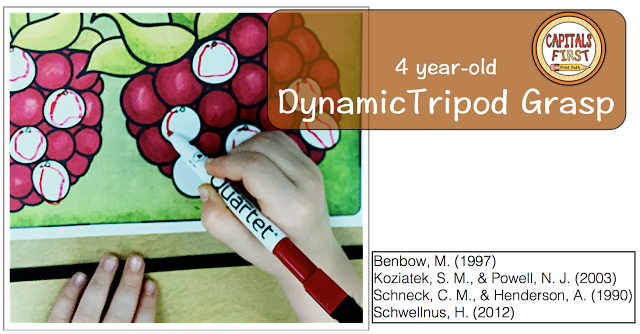 There are many different ways that children hold pencils, but grasps can be categorized as belonging to one of three categories. The first category can be described as using a whole hand; researchers call these “primitive grasps.” The second category is “static grasps,” and the third category includes five grasps which researchers have found to be fully “functional.”
There are many different ways that children hold pencils, but grasps can be categorized as belonging to one of three categories. The first category can be described as using a whole hand; researchers call these “primitive grasps.” The second category is “static grasps,” and the third category includes five grasps which researchers have found to be fully “functional.”
- What grasps look like in the major three categories.
- Why some grasps are more advantageous than others.
- What ages typically-developing children are using these three types of grasp.
- What four main factors interfere with pencil grasp development.
- What parents and teachers can do to address those factors.
- What tips and tricks OTs use to support the highest level grip a child is able to use.
- When pencil grippers should be used.
I do not like the name, but academic researchers consistently label these grasps as ‘Primitive.’ I have not provided individual names for each grasp as names vary by researcher, and there are several other creative ways to hold pencils that are less common and not pictured here. If you are a teacher and are having a discussion with a parent about their child’s grasp, consider saying the child is using a ‘whole hand grasp’ as opposed to ‘a fingertip grasp’ to avoid sounding judgmental. As you can see, even at 3 years old many children are not using a Primitive grasp, so while some visibly follow a developmental sequence, many just seem to skip the Primitive and Transitional stages (Schneck, C. M., & Henderson, A., 1990).
At first look, transitional grasps appear very similar to functional grasps. The big difference is that transitional grasps support the pencil on two sides rather than three. If you look at the static tripod you will see the index and middle finger both rest on the pencil at the pads of the fingertips. This results in the pencil being supported on one side by the finger pads and the other side by the thumb. If you look at the dynamic tripod found in the functional grasp section, you will see that the middle finger has shifted. When the middle finger shifts so that the child is using the side of that finger, the chid’s fingers are supporting the pencil from three sides [rather than two sides] and the grasp becomes dynamic.
You may be surprised to see that there are at least 5 different pencil grasps which research has shown to be fully functional. Researchers have found that children as old as those in the 4th and 5th grades, who use these grasps, are able to write fast, with fluidity, and without increased fatigue or discomfort. When I refer to functional pencil grasps, I am speaking about any one of these five grasps.
The advantage of the functional pencil grasps over transitional grasps is that because the pencil is fully supported on three sides, the child is able to move it in small discrete and controlled ways using the smallest muscles within the hand. While these small [intrinsic] muscles are not the strongest muscles, they allow for the precision that is needed for legible and automatic handwriting down the road.
- What four main factors interfere with pencil grasp development.
- What parents and teachers can do to address those factors.
 |
| In the Print Path store on Teachers Pay Teachers |
![]()
 Check out these great bloggers from Teacher Talk!
Check out these great bloggers from Teacher Talk!
[inlinkz_linkup id=677326 mode=1]











Thank you! I teach 3 – 4 year-old children and some find it very difficult to use tripod grip – the only one that is ever mentioned as THE ONLY right grasp. I will find some of the grips difficult after 50 or so years but at least I can show – and accept – alternative grasps that might better suit a particular kid.
Right! Unfortunately those grasps are hard to change in 4th grade. Thanks for your comments.
Great explanation of pencil grasp! I think that it is often a topic that is not brought to the fore front. I teach 4th grade and often I see pencil grasps that are awkward and inefficient for the student. Their hands often get tired more quickly than those with a functional pencil grasp. Great Article!